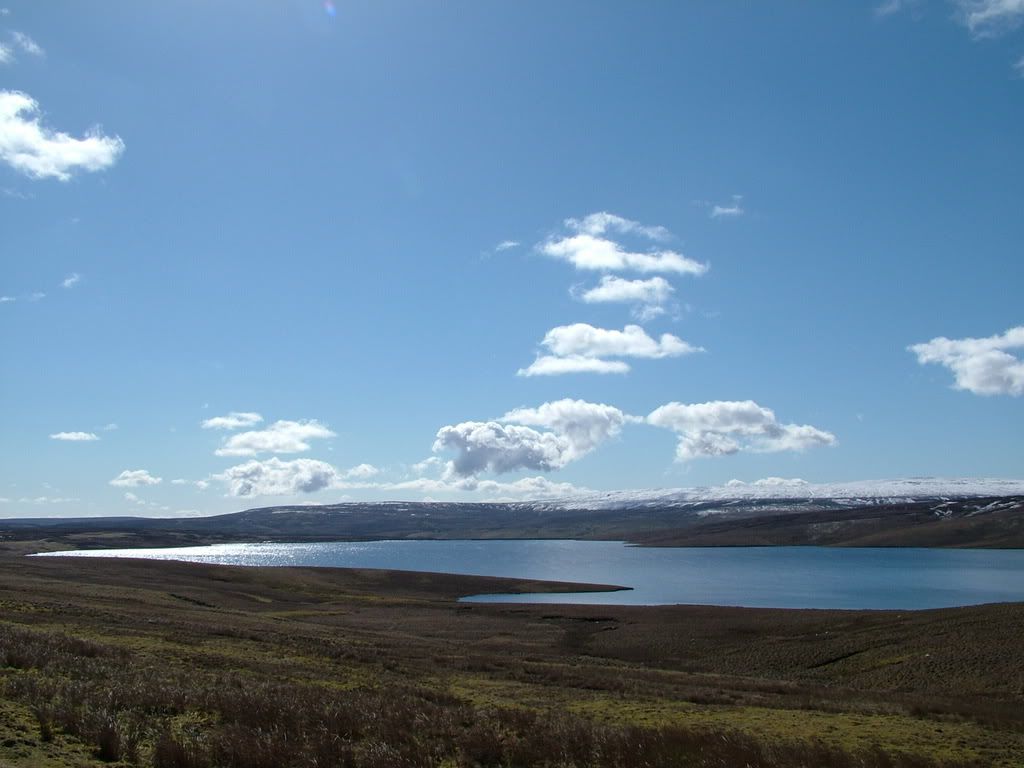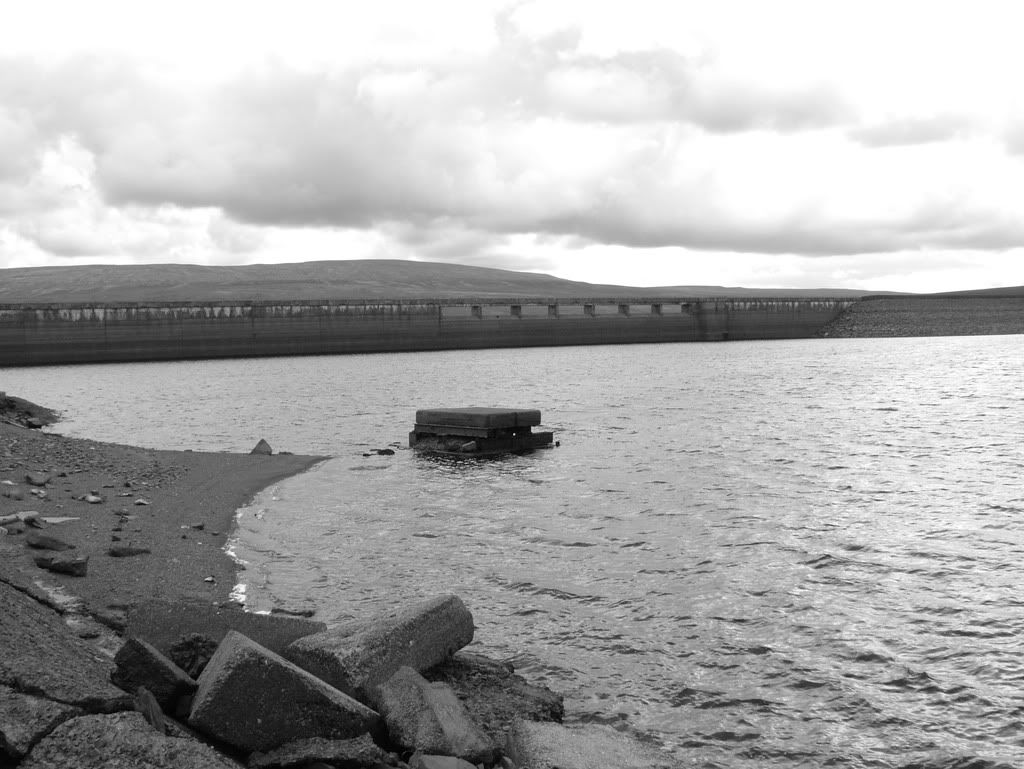







Cow Green Reservoir, in Upper Teesdale, County Durham, was born out of controversy. Built during the late sixties and opened in 1971 to serve Teesside industry its construction was vehemently opposed by conservationists, local and otherwise. Alfred Wainwright (1907-1991) the fellsman, philosopher and writer was dismayed at plans to submerge the Cow Green basin. In his Penine Way Companion (1968, Westmoreland Gazette. Available in facimile reprint published by Michael Joseph ISBN 07181 4009 5) Wainwright wrote: "Surely the beautiful Tees, of all northern rivers, was born to run free?"
Campaigners, Wainwright included, were outraged by the threat to the survival of the so-called Teesdale Assemblage, a group of rare, mainly alpine, plants including the spring gentian and the unique Teesdale violet. The pressing need of industry, however, proved too strong an opponent, and plans for the reservoir went ahead despite the protests.
The establishment of the Assemblage has its origins in the last Ice Age. Seeds, bourne from the north by the spreading ice, remained when the glaciers receded. The plants achieved a (somewhat tenuous) hold thanks to the unique geological conditions of the area and remain there still. For this we must thank those foresighted conservationists who painstakingly dug up and replanted hundreds of specimens above the reservoir's waterline where they remain, protected by the Moor House-Upper Teesdale National Nature Reserve.
The reservoir was created by damming the infant Tees a couple of miles from her source on the eastern flanks of Cross Fell, the summit of which marks the highest point of the Pennines (The second and third photos from the top show evidence of construction work and the site access road, revealed during low water levels in 2006). Damming the river this far up meant that the redds, in the feeder becks as well as the mother river, were now connected to a 670 acre expanse of water. The fish don't seem to have been adversely affected. After all, the reservoir gives them an opportunity to roam the vast expanse hunting terrestrial delicacies blown onto this inland, highland sea.
The peaty contents - run-off from the surrounding moorland - of these upland watercourses provides little in the way of nutrients for aquatic plantlife. Consequently, aquatic insects, too, are in short supply. In these conditions trout rely heavily on terrestrial morsels, blown onto the water, for their protein. The most successful methods I've found at Cow Green exploit these facts. I have found that to flaunt conventional wisdom and fish with the wind at one's back provides the best returns. Sometimes, to be honest, it is very difficult to cast any other way. Here, more often than not, the wind howls down the valley and across the water relentlessly and without restraint.
Try to get down among the boulders by the water's edge below a high bank with the wind behind you. The trout will, more than likely, be found patrolling the line between the calm in the lee of the bank and riffled water where the wind hits the surface. This is where terrestrials, blown from the heather, will be deposited. Fish appropriate imitations for the time of year just below the surface, and success will follow. Long casts are seldom necessary, and wading never, but vary the retrieve until you find something that works. On one occasion I found that stripping a size 14 bibio across the surface was the method of the day.
In Spring, and after rain, try the mouths of feeder becks and, especially, where the Tees enters the reservoir (see the fourth photo from the top). My advice would be to dispense with heavier tackle. When I first fished here, I used a typical 7wt reservoir setup. After a while I realised this was not necessary and I stepped down. I now use a 4wt setup most of the time, which gives excellent sport.
The fish you are likely to catch will be of the 3-to-a-pound variety, but they are genuine wild brownies. There are bigger fish, but they are rare. A trout of a pound is big - I've certainly never caught one. The lake record is, apparently, four pounds.
Personally, I prefer not to dispatch wild fish, so I crush the barbs and return them. For me, it is enough to fish in such elemental surroundings unchanged for thousands of years (apart from the reservoir that is). The last thing I want to do after trudging through knee-deep heather all day is clean trout when I get back to the cottage. I prefer instead to savour the hospitality of Teesdale's inestimable hostelries, or imbibe some good malt in front of the fire.
In Springtime, golden plover, curlew, lapwing, sandpiper, redshank, the rare black and ubiquitous red grouse are nesting, so watch your step. If you tie your own flies (as everyone should) take something with which to carry the numerous hackle feathers which can be gathered in abundance at this time, clinging to the clumps of heather. Later in the year greylag goose primaries, a source of biots, can often be found near the shoreline. Other birds to look out for include merlin, wheatear, buzzard, raven, meadow pipit, ring ouzel, oystercatcher, ringed plover and, if you're very fortunate, hen harrier.
Day tickets are obtained from a building down by the shoreline near the carpark at Wheelhead Syke. Payment is via an honesty box - so take £8 in change. If I remember rightly the limit is twelve fish. Coarse fishing is allowed, but I've never seen anyone doing so. In fact, in five or six trips I've only ever encountered one other angler.
Take as little as possible, it is a fair hike from the car park to the far end of the water. Much of the walking is across unkempt heather and it is like walking through treacle. Make sure, however, to take waterproofs; when it rains, it can rain hard.
The flies pictured have all caught for me at Cow Green. The list, however, is by no means comprehensive. march browns will work in early season, heather fly imitations and daddys later on, for example. The dressings are (as I tie them) in order from top to bottom:
KATE McLAREN
Hook: Any traditional wet hook size 12 - 16 (this one's a 14 Kamasan B170)
Thread: Black
Tail: Golden Pheasant Topping
Rib: Fine Oval Tinsel
Body: Black Seal Fur (or substitute)
Palmered Hackle: Black Hen
Collar Hackle: Brown or Red Game Hen
BLACK & PEACOCK SPIDER
Hook: As above
Thread: Black
Rib: Fine Copper Wire
Body: 3 Strands of Peacock Herl
Hackle: Black Hen
BIBIO
Hook: As above
Thread: Black
Rib: Fine, Flat Silver Tinsel
Body: Black/Red/Black Seals Fur (or substitute)
Palmer Hackle: Black Hen
Collar Hackle: Black Hen
BLAE & BLACK - but with starling slips. This is the one that has (perhaps surprisingly) worked well for me.
Hook: As above
Thread: Black
Tail: Golden Pheasant Tippets
Rib: Fine Silver Wire
Body: Black Seal Fur (or substitute)
Wings: Starling Secondary Slips, tied 'inside out' (convex sides back to back and inside - I know it's horribly wrong, but it worked, trust me)
Hackle: Black Hen
Map - Ordnance Survey - NY 813290
2 comments:
thanks for the info, just off to Cow Green now, my second visit so far this season, hope to do better than last month, 6 fish best 6oz
steve
Yes! Amazing picture all the picture looking so beautiful. And your blog is fabulous for a people who love fish or fishing like me I really enjoy your posts keep it up and I am waiting for more pictures keep it up and thanks for sharing. . And carpbuddy.com is a site that provides lots of carp fishing news and very useful information about carp .
Post a Comment